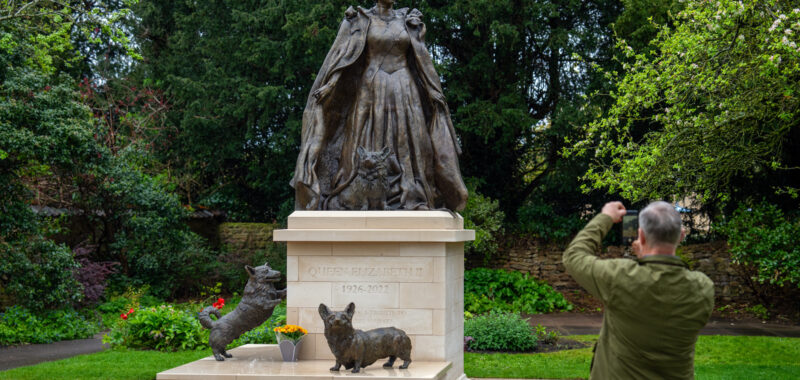The first posthumous statue of Queen Elizabeth II was unveiled outside the local library in Oakham, England, on Sunday, April 21, to a largely positive public response. The cheerful reactions can be primarily attributed to the sculptor Hywel Pratley’s decision to include three Corgis at the queen’s foot, pointing to the monarch’s storied affection for the breed throughout her lifetime. Though Corgis are somewhat emblematic of Queen Elizabeth’s reign, is this a premium example of art-washing the royal family? Or should I say, grooming the public to have an empathetic view of the late queen?
During the unveiling ceremony on what would have been the queen’s 98th birthday, Sarah Furness, the local dignitary who commissioned the sculpture from Pratley, said in a speech that “by showing Queen Elizabeth’s love of dogs, we show her humanity.” Pratley had also stated in an interview the little lowriders were “a metaphor for the security and safety the nation somehow felt during the Elizabethan era.”
I know this is England so I’m very much channeling a fruitless but somewhat cathartic “Old Man Yells at Cloud” energy here, but this format of commemorating the late queen as a dog momma with a heart of gold feels a bit too easy if not dated, considering Britons’ withering allegiance to the monarchy. The support for the royal family has been at a historic low since the queen’s 2022 death, especially as people from former British colonies regard the late monarch as the principal symbol of British imperialism.
Aside from the trio of pups that objectively stole the spotlight, Pratley’s seven-foot-tall statue of the queen presents her as a relatively younger woman — perhaps around the age of 40 — dressed in a billowing robe and a cascading gown, crowned with her diamond diadem. Poised and stoic, she stands above the public on a plinth with the Corgi at her feet placed well above eye level. Most commentators have lauded the sculpture in the same vein as Furness’s commentary about the queen’s humanity balanced with her majesty, though a handful have something to say about the accuracy of the depiction — or lack thereof.

Subjective imperfections aside, what matters is that you can’t bronze-cast away the queen’s complicity in grotesque abuses of power across the world. This calculated Corgi-washing of the queen’s public persona promotes a glorified familiarity with a woman whose dutiful troops and colonial administrators exacted torture, detention, starvation, deportation, and killing campaigns in order to maintain control over the colonies and thwart pushes for independence.
Hundreds of thousands of Kenyans subjected to horrific treatment through Britain’s collective punishment in response to the Mau Mau Uprising in the 1950s and the British military’s murder of 14 unarmed Derry protesters during Bloody Sunday in 1972 are just two bleeding feathers in the queen’s colonial cap that stacked up as the British Empire’s expiration date was imminent.
A statue like the one in Oakham implores the public to remain loyal to the monarchy like the fleet of Corgis that scampered by Elizabeth’s feet for the last 80 or so years, and since Pratley’s work is the first permanent memorial to the queen, I’m afraid this is just the beginning. But as the royal family unravels in the public eye and postcolonial voices dissipate the thick fog of British exceptionalism, it’s going to take more than three dog sculptures to soften the picture of injustice. Especially when their faces look like how I’m feeling:


